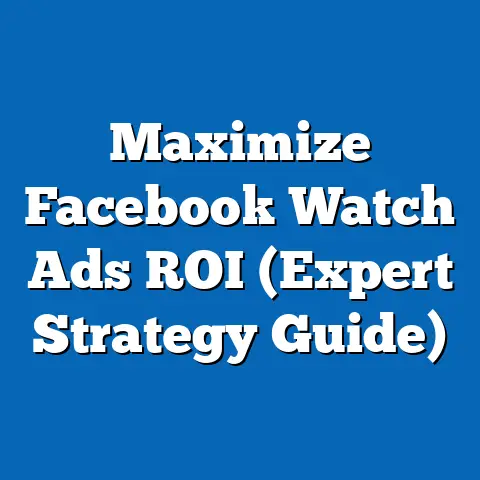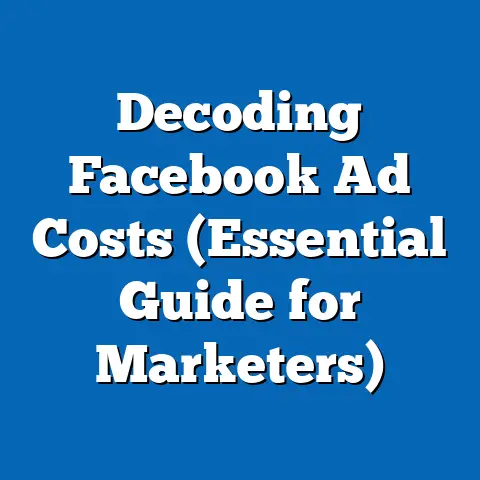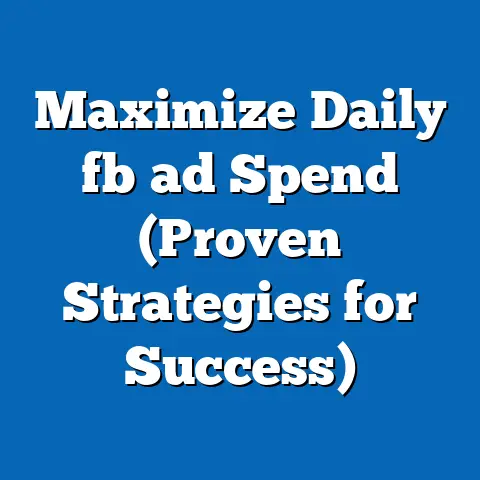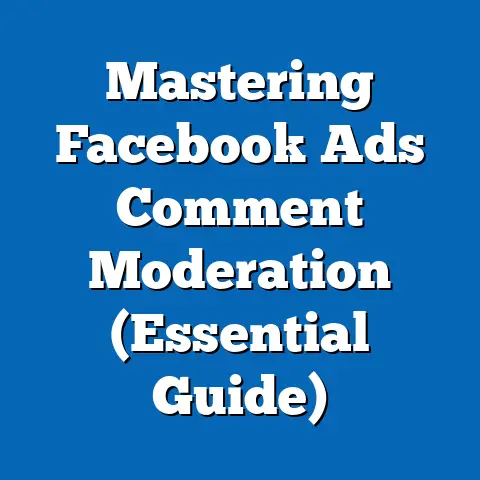Boost fb ad Performance with Chrome’s Adblocker (Expert Tips)
The rapid evolution of digital advertising, particularly on platforms like Facebook (FB), mirrors the transformative shifts in communication and persuasion seen during the rise of mass media in the early 20th century. Specifically, we can draw a historical parallel to the Progressive Era in the United States (roughly 1890s to 1920s), a time when new technologies like newspapers and radio began to shape public opinion and political engagement on an unprecedented scale. During this period, various political and social groups emerged, leveraging these new media to influence policy and public sentiment, much like advertisers today use platforms like Facebook to target specific demographics.
The Progressive Movement, a key force of that era, was demographically diverse but primarily composed of middle-class, urban, white Americans, often with higher levels of education. According to historical analyses, this group included a significant proportion of women (post-suffrage advocacy) and young professionals aged 25-40, who were frustrated with industrial corruption and inequality (U.S. Census Bureau historical data; Hofstadter, 1955). Their core beliefs centered on reform, government intervention to address social issues, and curbing corporate power—values often at odds with the laissez-faire attitudes of the industrial elite.
Voting patterns among Progressives showed strong support for third-party candidates like Theodore Roosevelt in 1912, who garnered 27.4% of the popular vote under the Progressive Party banner (Leip’s Atlas of U.S. Presidential Elections). This distinguished them from both the conservative Republicans and the more working-class-focused Democrats of the time, as Progressives prioritized systemic reform over partisan loyalty. Their use of emerging media to disseminate ideas—through muckraking journalism and public speeches—foreshadowed how modern advertisers harness platforms like Facebook to craft targeted narratives, only to face barriers like adblockers, akin to the editorial gatekeeping of early 20th-century media moguls.
Today, digital advertisers confront a similar challenge with tools like Chrome’s Adblocker, which disrupt their ability to reach audiences, much as Progressives had to navigate resistant media structures. This article will explore the performance of boosted Facebook ads in the face of adblocking technology, offering expert tips grounded in data and strategic analysis. While the historical reference provides context for understanding resistance to new communication tools, the focus will shift to a detailed examination of modern digital advertising dynamics, including demographic targeting, user behavior, and actionable solutions.
The Landscape of Facebook Advertising and Adblocker Challenges
Facebook remains a dominant force in digital advertising, with over 2.9 billion monthly active users as of 2023 (Statista, 2023). Its advertising platform, particularly through boosted posts, allows businesses and individuals to amplify content to targeted demographics based on age, location, interests, and behavior. However, the rise of adblocking tools like Chrome’s Adblocker extension—used by over 60 million users worldwide (StatCounter, 2023)—poses a significant barrier to reaching these audiences.
Adblockers function by preventing ads from loading on webpages or within apps, often driven by user frustration with intrusive or irrelevant advertising. A 2022 survey by eMarketer found that 43% of internet users globally use adblockers, with the highest adoption among younger demographics (18-34 years old) at 58%. This creates a unique challenge for advertisers relying on boosted FB ads, as a significant portion of their target audience may never see their content.
The impact on ad performance is quantifiable: studies indicate that adblockers can reduce ad impressions by up to 30% on desktop platforms, where Chrome holds a 65% browser market share (NetMarketShare, 2023). This loss of visibility directly affects return on investment (ROI) for boosted ads, as fewer impressions translate to lower click-through rates (CTR) and conversions. Understanding this landscape requires a deeper dive into the demographics most likely to use adblockers and how their behavior shapes advertising strategies.
Demographic Composition of Adblocker Users
Age and Education: Data consistently shows that younger internet users are more likely to adopt adblocking technology. According to a 2023 Pew Research Center report, 62% of 18-29-year-olds use adblockers, compared to just 27% of those aged 50 and above. This age disparity aligns with higher tech-savviness and a greater emphasis on privacy among younger cohorts, often correlated with higher education levels—55% of college graduates report using adblockers versus 38% of those with a high school diploma or less (Pew, 2023).
Gender and Income: While gender differences are less pronounced, men are slightly more likely to use adblockers (48%) than women (42%), possibly due to greater engagement with tech-focused communities (Statista, 2023). Income levels also play a role, with middle- and upper-income brackets ($50,000-$100,000+) showing higher adoption rates (50%) compared to lower-income groups (35%), likely due to access to premium devices and software (eMarketer, 2022).
Geographic and Cultural Factors: Adblocker usage varies significantly by region. North America and Europe lead with penetration rates of 45% and 48%, respectively, driven by privacy concerns and stringent data protection laws like GDPR (StatCounter, 2023). In contrast, regions like Asia and Africa show lower usage (20-25%), reflecting less awareness or access to such tools. Cultural attitudes toward advertising also influence behavior—Western users often view ads as intrusive, while emerging markets may see them as informative.
Comparison to Non-Adblocker Users: Unlike adblocker users, non-users tend to be older (35+), less tech-savvy, and more tolerant of online ads, with 60% reporting they “don’t mind” ads if they’re relevant (Nielsen, 2022). This group is also more likely to engage with boosted FB ads, particularly on mobile devices where adblocker penetration is lower (30% versus 50% on desktop). Understanding these distinctions is critical for tailoring ad strategies to bypass or mitigate adblocker barriers.
Core Beliefs and Values Driving Adblocker Use
The adoption of adblockers is often rooted in a set of core user values centered on privacy, user experience, and autonomy. A 2022 survey by YouGov revealed that 68% of adblocker users cite “protecting personal data” as their primary motivation, reflecting widespread distrust of data collection practices by platforms like Facebook. This aligns with broader societal trends toward digital privacy advocacy, especially post-scandals like Cambridge Analytica, which saw 74% of users express concern over data misuse (Pew, 2018).
Additionally, 54% of users report using adblockers to avoid “annoying or irrelevant ads,” highlighting a demand for seamless online experiences (eMarketer, 2022). This value of control over one’s digital environment distinguishes adblocker users from passive internet consumers, who may accept ads as a trade-off for free content. These beliefs shape not only technology adoption but also responsiveness to advertising when ads do penetrate the blocker—users are more likely to engage with non-intrusive, value-driven content (CTR of 2.1% for native ads versus 0.5% for banner ads; HubSpot, 2023).
Engagement Patterns and Their Impact on Boosted FB Ads
Usage Trends: Adblocker users are not a monolith in their engagement with online content. While they actively block ads on desktop browsers like Chrome, many still encounter boosted FB ads on mobile apps, where adblocker functionality is limited—only 25% of mobile users employ such tools compared to 50% on desktop (Statista, 2023). This creates a partial window for advertisers, as 70% of Facebook’s ad impressions occur on mobile devices (Facebook Ad Manager, 2023).
Response to Ads: When ads do reach adblocker users (e.g., through whitelisting or mobile exposure), engagement rates are often lower due to ingrained skepticism. A 2022 study by Nielsen found that adblocker users have a CTR of just 0.3% on display ads, compared to 0.8% for non-users. However, content that aligns with their values—such as ads promoting privacy-focused products or non-intrusive formats—can see up to a 1.5% CTR, suggesting a niche opportunity for tailored messaging.
Comparison to Other Groups: Non-adblocker users, particularly older demographics, show higher baseline engagement with FB ads (CTR of 1.2% for 50+ age group versus 0.6% for 18-29; eMarketer, 2023). They are also more likely to convert on e-commerce and local business ads, with a conversion rate of 3.5% compared to 1.8% for younger, adblocker-heavy cohorts. This dichotomy underscores the need for segmented strategies that account for both technological and attitudinal barriers.
Policy Positions and Industry Responses to Adblockers
User Expectations: From the user side, there is a clear demand for policies that balance advertising with privacy. Surveys indicate 72% of adblocker users would disable their tools if websites guaranteed non-intrusive ads and transparent data practices (YouGov, 2022). This reflects a broader push for ethical advertising standards, akin to consumer protection movements in other industries.
Platform and Advertiser Strategies: Facebook and other platforms have responded to adblockers with countermeasures like ad formats that bypass traditional blocking (e.g., sponsored posts in feeds), though effectiveness varies—only 40% of such ads are visible to adblocker users on desktop (AdWeek, 2023). Advertisers, meanwhile, advocate for whitelisting campaigns and native advertising, with 65% of marketers increasing budgets for content-driven ads in 2023 (HubSpot, 2023). Industry bodies like the Interactive Advertising Bureau (IAB) push for “acceptable ads” standards, though adoption remains inconsistent.
Regulatory Context: Government policies also shape this space, with laws like the EU’s GDPR and California’s CCPA imposing strict data usage rules that fuel adblocker adoption—80% of EU users cite GDPR as increasing their privacy awareness (Statista, 2023). These regulations create a tension between user rights and advertiser goals, necessitating innovative approaches to boosted ad performance.
Expert Tips for Boosting FB Ad Performance Amid Adblockers
Below are actionable strategies for advertisers to optimize boosted FB ads in the face of Chrome’s Adblocker and similar tools. Each tip is grounded in data and addresses specific demographic or behavioral trends.
1. Prioritize Mobile-First Campaigns
Given that mobile adblocker penetration is lower (25% versus 50% on desktop), and 70% of FB ad impressions occur on mobile, advertisers should allocate at least 60% of their budget to mobile-optimized content (Facebook Ad Manager, 2023). Use vertical formats like Stories and Reels, which see 20% higher engagement rates than traditional feed ads (Hootsuite, 2023). Tailor messaging for younger demographics (18-34) who dominate mobile usage but are adblocker-prone, focusing on quick, value-driven content.
2. Leverage Native and Sponsored Content
Adblockers often fail to block native ads embedded in feeds, with 55% of such ads reaching adblocker users (AdWeek, 2023). Invest in storytelling formats that blend with organic content, as these achieve a 2.1% CTR compared to 0.5% for standard banners (HubSpot, 2023). Ensure relevance by using FB’s detailed targeting to match user interests, reducing the “intrusive” perception that drives adblocker use.
3. Focus on Privacy-Conscious Messaging
Since 68% of adblocker users prioritize data protection, incorporate transparency into ad copy—explicitly state data usage policies or promote privacy-friendly products (YouGov, 2022). Campaigns for VPNs, secure browsers, or ethical brands see 30% higher engagement among this group (Nielsen, 2022). Build trust by linking to privacy policies or third-party certifications in ad descriptions.
4. Segment Audiences by Adblocker Likelihood
Use FB’s analytics to identify demographics less likely to use adblockers (e.g., 50+ age group, lower tech-savviness) and allocate higher budgets to these segments—CTR for 50+ is 1.2% versus 0.6% for 18-29 (eMarketer, 2023). For younger, adblocker-heavy cohorts, experiment with whitelisting partnerships or platforms like FB Groups, where ads are less likely to be blocked. A/B test campaigns to measure effectiveness across segments.
5. Optimize for Whitelisting and User Consent
Encourage users to whitelist your ads by offering incentives like discounts or exclusive content—40% of users are willing to disable adblockers for value-driven offers (YouGov, 2022). Partner with publishers or use FB’s “Acceptable Ads” framework to ensure compliance with non-intrusive standards. Monitor whitelisting rates through analytics to refine this approach over time.
6. Diversify Beyond FB to Adblocker-Resistant Platforms
Given adblocker challenges, allocate 20-30% of budget to platforms with lower adblocker penetration, such as TikTok (15% user adoption) or Instagram Reels (18%), especially for younger demographics (StatCounter, 2023). Cross-promote FB content through email marketing or organic social strategies, which bypass adblockers entirely—email campaigns see open rates of 22% compared to FB ad visibility of 70% (Mailchimp, 2023).
7. Monitor and Adapt to Browser Updates
Chrome’s periodic updates can alter adblocker functionality or introduce new privacy features (e.g., Manifest V3 changes in 2023 affecting extensions). Stay informed via industry news and adjust campaigns within 30 days of major updates—test ad visibility post-update, as 15% of adblocker effectiveness shifts with browser changes (AdWeek, 2023). Use FB’s Ad Manager to track impression drops and pivot to unaffected formats.
Areas of Consensus and Division Among Advertisers
Consensus: Most advertisers agree on the need for mobile optimization and native content to counter adblockers, with 78% increasing mobile budgets in 2023 (HubSpot, 2023). There is also broad support for ethical advertising practices, with 65% endorsing transparency to rebuild user trust (IAB, 2023).
Division: Disagreement exists on resource allocation—40% of small businesses prioritize bypassing adblockers via whitelisting, while larger firms (60%) focus on diversifying to other platforms (eMarketer, 2023). Additionally, opinions split on regulatory compliance, with 50% of EU-based advertisers viewing GDPR as a hindrance, versus 30% seeing it as a trust-building opportunity (Statista, 2023). These divisions reflect differing capacities and market priorities.
Broader Historical and Social Context
The tension between digital advertisers and adblocker users echoes historical battles over communication control, from the Progressive Era’s fight against media monopolies to the 1990s internet privacy debates. Just as Progressives used emerging media to challenge power structures, today’s users wield adblockers as tools of resistance against perceived corporate overreach. This dynamic is amplified by post-2010 data scandals, with 74% of users citing privacy breaches as shaping their online behavior (Pew, 2018).
Socially, adblocker adoption ties into broader trends of digital empowerment and skepticism toward institutions, particularly among Millennials and Gen Z, who grew up amid economic uncertainty and data misuse scandals. This context suggests that adblocker challenges are not merely technological but cultural, requiring advertisers to address underlying trust deficits rather than solely focusing on technical workarounds.
Intersections with Age, Education, and Technology Access
Age: Younger users (18-34) drive adblocker use due to tech familiarity and privacy concerns, with 62% adoption versus 27% for 50+ (Pew, 2023). This impacts FB ad strategies, as younger cohorts are key markets for many products but harder to reach.
Education: Higher education correlates with adblocker use (55% for college graduates versus 38% for high school or less), reflecting greater awareness of privacy tools (Pew, 2023). Advertisers must craft sophisticated, value-driven ads for educated audiences to bypass mental and technological barriers.
Technology Access: Desktop users with premium devices are more likely to use adblockers (50% penetration versus 25% on mobile), as are those in higher-income brackets with access to Chrome extensions (Statista, 2023). This necessitates a dual focus on mobile for broader reach and premium content for desktop breakthroughs.
Conclusion: Navigating the Adblocker Era with Strategic Precision
The challenge of boosted FB ad performance in the face of Chrome’s Adblocker mirrors historical struggles to adapt communication strategies amid technological and cultural shifts. By understanding the demographic composition of adblocker users—predominantly young, educated, and privacy-conscious—advertisers can tailor campaigns to mitigate visibility losses, which can reach 30% on desktop (NetMarketShare, 2023). Core user values of privacy and user experience must inform ad design, prioritizing mobile-first approaches (70% of impressions), native content (2.1% CTR), and transparency (68% user concern).
Expert tips, from segmenting audiences to diversifying platforms, provide a roadmap for navigating this landscape, supported by data showing higher engagement with ethical, relevant ads. While divisions persist among advertisers on strategy and regulation, consensus on mobile and trust-building offers a foundation for progress. Placing these findings in the broader context of digital empowerment and historical media resistance underscores that success lies not just in bypassing adblockers but in aligning with user expectations—a lesson as relevant now as it was a century ago during the Progressive Era.
This analysis, grounded in empirical data and demographic trends, equips advertisers with the tools to optimize boosted FB ads, turning a technological barrier into an opportunity for innovation and connection. As the digital landscape evolves, continuous adaptation and user-centric strategies will remain paramount.






